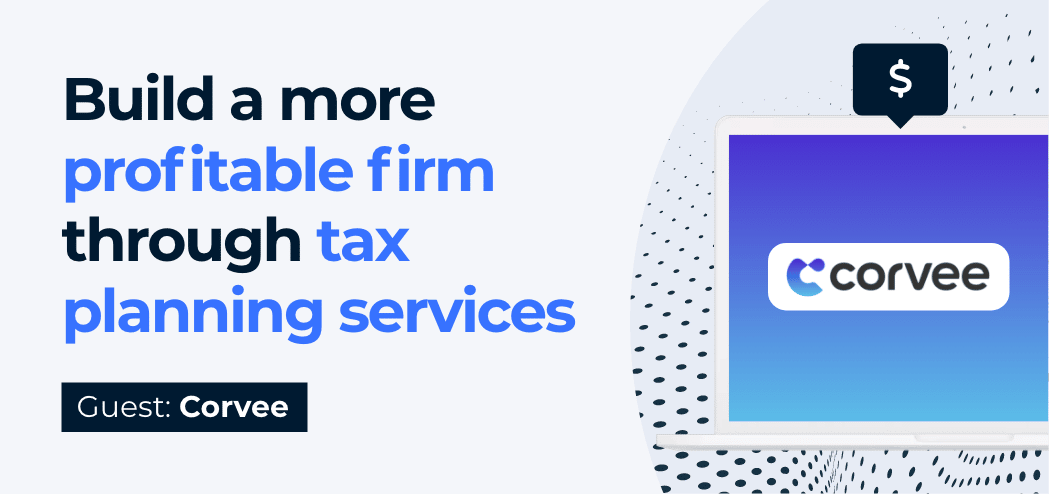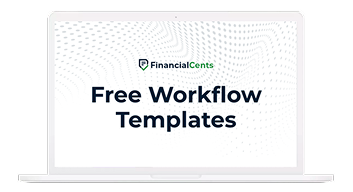Learn how firm owners like you are increasing revenue and profitability by offering tax planning services.
Written by our friends at Corvee.
Too many firms are stuck in a vicious revenue cycle. Their business is far too seasonal with periods of intense busyness followed by slower times where they catch their breath before the next busy season accounting commences. To get off this roller coaster, relieve stress, and see more consistent success heading into 2023, it’s vital to pivot from primarily compliance to advisory services.
Accountants who add tax advisory services (TAS) to their offerings are seeing enormous success in recent years. This is majorly because they are already seen as an all-in-one tax and accounting partner to their clients, so many clients are more than willing to have most (if not all) their tax-related tasks done on a profitable quarterly, or monthly recurring revenue model.
These TAS services include tax planning, deciding on tax positions, implementing tax strategies, estimating taxes owed, making quarterly payments, and filing annual tax returns. In addition, TAS can be easily combined with recurring client accounting services (CAS).
How to Grow an Accounting Firm
There are multiple ways to grow revenue, and firms that focus on CAS need to transition to CAS + TAS engagements. This means new processes such as how often you meet with clients, what new scope of work you’ll be doing along with fresh billing arrangements. But to even begin all this you must be able to sell clients on the value of tax advisory.
You must know how to price tax advisory for profitability, and then you need to know the tax strategies that you can offer clients. All of this presents a challenge to adding tax advisory since there are so many moving parts.
Many firm owners might want to make the transition to TAS but they have no idea how long the transition process takes, how existing clients will react to the firm’s transition, and no clear roadmap on how to begin tax planning right away. It’s a barrier that stops many, and why so many firms are stuck in the status quo—even though they are struggling to grow with tight margins. The fact is, many firms feel safer doing what they’ve always done rather than expanding into TAS.
Is There Really a Barrier to Tax Advisory Services?
Despite the appearance of many obstacles, the path for firms to begin offering TAS is actually much easier than it used to be. Technology has improved to the point where software can now automate much of the tax planning process. For example, a firm owner can input data from a client and see within minutes which specific tax strategies fit their client’s scenario.
Since the technical aspect of tax planning becomes economical with software, a tax plan can be created fast, which means there is potential for great margin. But how does a firm actually sell a tax plan?
It’s difficult to imagine charging a client between $2,500 to $9,800 for a tax plan when they’re used to low-priced preparation and want to pay $700 or less.
While it’s true tax preparation is a cost, tax planning is an investment with a specific ROI. That’s why firms can charge much more even though it takes less time to deliver. However, your clients have to understand the ROI they’re getting. That’s the key to everything. Then they’ll be eager to pay fees much higher than $700.
Getting Started With TAS
So, when you’re tax planning, you might say to a client, for example, “I estimate you overpaid $19,250 last year and are on track to overpay $20,383 this year. By next year you’ll be overpaying $23,750.” In short, clients must understand they are paying the IRS more than they need to because they aren’t investing in a tax advisory engagement.
In essence, you must show the problem. Once a client realizes how much a tax plan costs relative to the amount they are overpaying, the sale becomes easy to make. Would you pay for a $7,000 tax plan if you were told you were paying the IRS over $25,000? Once you realize you aren’t taking advantage of certain tax deductions and credits, you want to start!
That’s why the key to pricing tax planning is that the client gets a better deal than you do — although the deal for you is often significantly better than most of your compliance-based engagements. The key is that the client knows they are getting ROI.
TAS Is Not As Difficult As You Think
Make no mistake about it, once you begin TAS there are challenges. However, once you learn the basic tax strategies, it should be easy to begin seeking appointments with your existing clients. Don’t just send out a mass email. Instead, look carefully at your client list and sort the list from biggest client to smallest—and start reaching out in that order.
Typically, high-earning or high net-worth clients can benefit the most from TAS. So, once you pinpoint which clients would be most likely to benefit from a tax plan, you can directly text or phone them. Depending on how you communicate with your clients, you could simply ask, “Hey Bob, thought of you today. Are you free to talk tomorrow?”
That gets their attention. If you have hundreds or thousands of clients, this direct outreach to a select few will get you the fastest results. If you prefer, you can also do a quick a little video and put it on a landing page, then directly message your clients to watch that video. Just remember to make it personable so that each client feels you are speaking to them and not a generic mass audience.
This method makes getting a TAS appointment not that difficult. The bigger challenge is selling them on the value of doing a tax plan. During the TAS sales call, don’t sell specific strategies. For example, if you just end the call saying, “I’m going to give you a piece of paper explaining the Late S Election Strategy,” the client won’t want to move forward—especially with a large estimated price tag of $3,500.
Instead, to sell TAS you must explain the process and the outcome, not the specific strategies. You’re selling a comprehensive review of possible deductions, optimizing legal entity structures, retirement & insurance optimization, advanced strategies and much more.
The challenge that every firm has when beginning TAS is the need to show a client their previous year return, current year return, a plan for next year’s return, along with an estimated savings amount calculated on the same sales consultation.
This is where software helps with quickly calculating strategies so you have real estimates to give clients to make a decision with.
How Long Does it Take to Transition to TAS?
Contrary to popular thought, it does not take years. You can get started in weeks and be fully running on TAS in a few short months. You’re not learning the entire tax code if you’re using technology that automates the finding of strategies. You’ll find many of your existing clients will be happy about switching to more pricey tax advisory fee models because they’ll be getting more value.
Firms have revolutionized their entire business model in under 6 months—it’s actually very common. While the market is saturated with accounting firms offering CAS and tax prep, there is little competition for tax advisory. Firms that can do tax planning, therefore, are at a competitive advantage and should see their margins and revenues increase in 2023.






